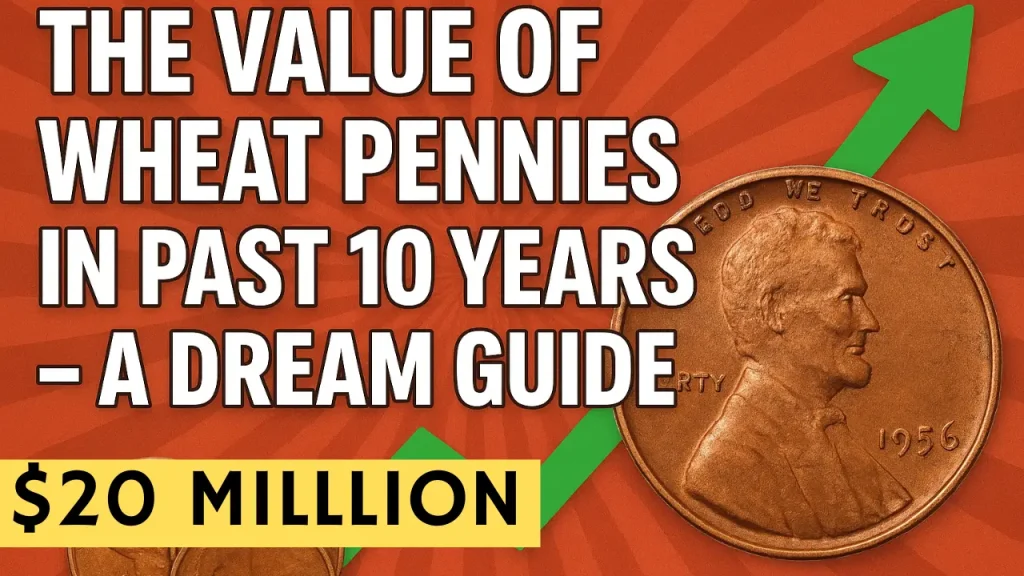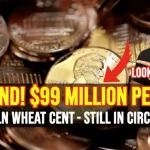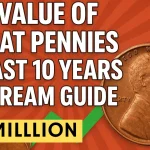In everyday life, a penny barely gets a second glance. It rolls under car seats, jingles at the bottom of pockets, or ends up forgotten in old jars. Yet among these copper-colored coins, there exists a version so rare and historically powerful that experts say it could be worth up to $99 million — possibly even more if the right collector enters the bidding war.
This famous coin is the 1943 copper Lincoln wheat penny — a minting error that transformed an ordinary cent into the ultimate treasure of American numismatics. The most astonishing detail?
A handful are still believed to be circulating unknowingly through the economy.
Anyone holding a penny could be holding a fortune. Every coin jar in America now holds a spark of possibility.
How a Wartime Mistake Created a Legendary Coin
The history of this rare penny begins during one of the most intense eras in modern history — World War II. In 1943, copper was urgently needed for ammunition and electrical components essential for the battlefield. To support the war effort, the U.S. Mint made a crucial manufacturing change:
Instead of copper, pennies were struck from zinc-coated steel.
But a surprising error occurred. A few leftover copper planchets (blanks) from 1942 accidentally slipped into the presses. They were stamped with the 1943 design and released into circulation.
This was not a planned or authorized minting — the accidental result of industrial oversight during high-pressure wartime production.
These error coins slipped into circulation unnoticed, and for years nobody fully realized what had happened.
Just How Rare Are These Pennies?
Numismatists estimate:
| Category | Estimated Quantity | Status |
|---|---|---|
| Confirmed authentic specimens | 19 | Studied and certified |
| Believed still undiscovered | 2–3 | In circulation or private holdings |
| Total estimated minted | 20–22 | Error production |
To put that rarity in perspective:
Over 1 billion steel pennies were minted in 1943.
Fewer than 20 copper ones survived.
That makes this coin rarer than many diamonds, artworks, and even historic gold pieces.
Why This Penny Is Worth Millions
Three major forces drive its unprecedented valuation:
| Factor | Description | Value Impact |
|---|---|---|
| Extreme rarity | Fewer than 20 known worldwide | Insane collector competition |
| Wartime history | Created during WWII copper rationing | Adds national and emotional significance |
| Global demand | Desired by every major collector | Auction prices skyrocket |
Collectors refer to it as:
“The Holy Grail of U.S. coins.”
The idea that something so ordinary could be worth a lifetime of wealth adds mystery, cinematic drama, and worldwide obsession.
How to Identify a Genuine 1943 Copper Wheat Penny
Here are the exact traits to look for if you think you’ve found one:
1️⃣ The Date
The coin must clearly show the year:
1943 below Abraham Lincoln’s portrait
2️⃣ The Material
A true coin is copper, not silver-gray like 1943 steel cents.
3️⃣ The Design
Classic wheat stalks on the reverse side
(This design existed from 1909 to 1958.)
4️⃣ Weight Test
| Material | Approximate Weight |
|---|---|
| Genuine copper version | 3.11 grams |
| Common steel version | 2.7 grams |
A small jewelry scale can reveal the difference instantly.
5️⃣ Magnet Test
Because steel is magnetic:
| Test | Genuine Copper Penny | Fake Steel Penny |
|---|---|---|
| Magnet | Will not stick | Will stick immediately |
If it sticks to a magnet — it’s a steel penny, not the million-dollar version.
Beware of Counterfeits and Date Alterations
Some counterfeits are created by:
-
Copper-plating genuine 1943 steel pennies
-
Filing down the numbers on 1945 or 1948 copper pennies
The only safe method to confirm authenticity is:
✅ Professional grading
from PCGS or NGC — the top U.S. coin certification groups
These companies use metallurgy, detailed die matching, and advanced scanning to ensure the coin is real.
A certified 1943 copper penny is sealed in a tamper-proof holder that verifies its grade and authenticity — the only way it can sell at high-value auctions.
The First Discovery: A Teenager’s Unexpected Fortune
In 1947, Don Lutes Jr., a 16-year-old high school student from Massachusetts, spotted a strange penny in his cafeteria change. The Mint initially dismissed him, saying no such coin could exist.
Decades later, authentication proved he was right. In 2019, his coin sold at auction for:
$204,000
— far below what experts believe the best examples could achieve today.
That discovery sparked a nationwide treasure hunt — one that continues to this day.
Record Auction Sales for the 1943 Copper Penny
| Year | Coin Grade | Selling Price | Notes |
|---|---|---|---|
| 1958 | Very Fine | $40,000 | Private sale |
| 1981 | Extremely Fine | $82,500 | Numismatic milestone |
| 1996 | Mint State | $143,750 | Collector bidding war |
| 2010 | Brilliant Uncirculated | $1.7 Million | Private buyer |
| 2019 | Lutes Specimen | $204,000 | Historical discovery sale |
Auction specialists agree:
A flawless, museum-grade piece could command $50–$99 million at any moment.
In fact, many believe the first coin to hit a $100 million price tag won’t be art or gold — but a penny.
Why People Are Still Searching — and Why You Should Too
Numismatists strongly believe a few coins remain undiscovered. Where could they be?
Likely hidden inside:
-
Old family change jars
-
Inherited coin collections
-
Bank rolls stashed away generations ago
-
Antique furniture drawers
-
Long-forgotten piggy banks
Coins circulate for decades, and collectors only found these coins by accident — which means the next discovery could be completely random.
Imagine the shock:
🎯 A penny worth more than a Ferrari
🎯 A penny more valuable than a mansion
🎯 A penny that could change someone’s life forever
That possibility keeps Americans checking their pockets every day.
Why This Coin Captured the World’s Imagination
Beyond monetary value, this penny carries symbolism:
-
Industrial transformation during wartime
-
An engineering mistake that became history
-
A reminder of how ordinary moments can become extraordinary
-
A treasure hunt still alive today
It represents a perfect blend of:
History + Mystery + Wealth
Compared to Other Rare U.S. Coins
Even among America’s greatest rarities, the 1943 copper penny stands alone:
| Coin | Year | Known Examples | Estimated Max Value | Why It’s Rare |
|---|---|---|---|---|
| Lincoln Copper Penny | 1943 | < 20 | Up to $99M | Accidental copper minting during steel year |
| Liberty Head Nickel | 1913 | 5 | $5M+ | Secret, unauthorized minting |
| Barber Dime | 1894 | 9 | $3M+ | Extremely limited minting |
| Double Eagle Gold Coin | 1933 | 13 | $18M+ | Illegal to privately own for decades |
| Lincoln Cent S-VDB | 1909 | 484,000 | Up to $50K | Design recalled after controversy |
The 1943 copper penny remains the rarest practical currency ever spent in America.
Could Its Value Reach $100 Million?
Experts are nearly unanimous:
✔ Demand is rising globally
✔ Collectors from Asia and Europe now bid heavily
✔ Wealthy investors use rare coins as long-term assets
✔ Only one collector can own a top-graded piece
Like rare art and gold, this coin offers:
-
Historical importance
-
Zero reproduction risk
-
Global liquidity
-
Museum-grade significance
If two billionaires compete — prices could skyrocket beyond anything ever seen in coin auctions.
The Authentication Science Behind the Treasure
Grading organizations now use:
-
Metallurgical analysis
-
Spectroscopy
-
Microscopy die matching
-
Precision weight/dimension testing
-
3D scanning of surface details
Once authenticated, the coin receives a Sheldon Scale grade from 1 to 70:
| Grade | Classification | Value Potential |
|---|---|---|
| VF 20–30 | Very Fine | Six-figure range |
| MS 60–65 | Mint State | Millions |
| MS 66–68 | Museum-quality | Could exceed $99M |
Only two or three known examples have ever approached the highest tiers.
Where History Meets Hope
The idea that a life-changing treasure could be hidden in the smallest, most ordinary object — a penny — gives the story emotional power.
Children check change jars. Grandparents pull coins out of drawers. Collectors hunt relentlessly. People who never cared about coins suddenly become detectives.
The legend of the 1943 copper penny continues to spark:
-
Excitement
-
Curiosity
-
Possibility
-
The dream of discovery
It proves that history can hide in the most unexpected places.
What to Do If You Think You Have One
Step-by-step guide:
1️⃣ Compare color: Copper, not silver-gray
2️⃣ Check the date carefully: 1943
3️⃣ Use a magnet: It should not stick
4️⃣ Weigh the coin: Should be 3.11 grams
5️⃣ If all these match — do not clean it or modify it
6️⃣ Contact a certified grading company for authentication
If it’s real?
You’ve just become a millionaire — possibly a multi-millionaire.
Conclusion: The Penny Everyone Is Still Searching For
No other coin in U.S. history inspires such awe and intrigue. The 1943 copper Lincoln wheat penny was created by chance, discovered by luck, and continues to challenge collectors nearly a century later.
Somewhere, a few of these legendary pennies may still be tucked away, waiting for someone to notice their faded shine — and transform an ordinary moment into extraordinary wealth.
So check your pockets. Check that dusty jar. Check the change you receive today.
Because the most valuable coin in the world might already be in your hands.
And all it would cost you is a second look.












Leave a Comment